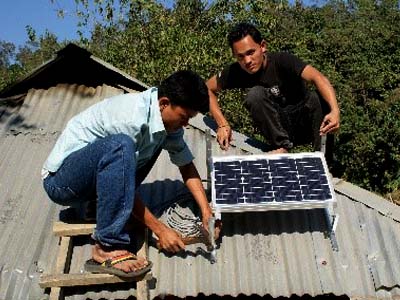
Solar energy is the energy; the earth receives from the sun, primarily as visible light and other forms of electromagnetic radiation. Solar energy is the radiant light and heat from the sun that has been harnessed by humans since ancient times using a range of ever-evolving technologies. Solar radiation is along with the secondary solar resources of account for most of the renewable energy available in the world.
Power is one of the most important factors in developing the economy and the standard of living of a country. Like the rest of the countries of the world, in Bangladesh the demand for power is increasing day by day.
Solar energy technologies refer primarily to the use of solar radiation for practical ends. All other renewable energies other than geothermal derive, their energy from energy received from the sun. Solar technologies are broadly characterized as either passive solar or active solar depending on the way they capture, convert and distribute sunlight. Active solar techniques include the use of photovoltaic modules (also called photovoltaic panels) to convert sunlight into useful outputs. Passive solar techniques include orienting a building to the Sun, selecting materials with favourable thermal mass or light dispersing properties, and designing spaces that naturally circulate air.
The Infrastructure Development Company Limited (IDCOL) in Bangladesh cooperated with international and local partners to install solar home systems in remote rural areas, which are not easily accessed by the national electricity grid. The focus was on providing basic electricity coverage to improve the life of rural regions and low-income households in Bangladesh. As of May 2017, over 4 million solar home systems had been installed, impacting more than 12% of the entire Bangladeshi population.
A combination of limited access to infrastructure and the dispersed nature of rural settlements have provided significant obstacles to achieving universal electrification. Therefore, the Bangladeshi government considered off-grid renewable energy technology to be one of the best options for bringing electricity to rural areas, where more than 70% of the population live.
The Solar Home Systems (SHS) initiative began in January 2003 and was facilitated by the government-owned Infrastructure Development Company Limited (IDCOL). The aim was to “fulfil basic electricity requirement of the off-grid rural people of Bangladesh". IDCOL was set up in 1997 to finance the development of medium- to large-scale infrastructure and renewable energy projects in Bangladesh. By June 2003, IDCOL’s international partners, such as the World Bank and the International Development Association (IDA) had joined forces to support the SHS initiative via the first Rural Electrification and Renewable Energy Development Project (RERED). The project was set up with selected local partner organisations (POs) as the main promoters of SHS.
The SHS project has had a significant positive impact, reaching roughly 12 % of the entire Bangladeshi population. When the project was initiated in 2003, roughly 12,000 SHS had already been installed in Bangladesh and the target was to install 50,000 systems by 2008. This target was achieved three years ahead of schedule in 2005. By May 2017, 4.12 million SHS systems had been installed, with a focus on areas where electrification and grid expansion were particularly challenging.
Before SHS, kerosene lamps were commonly used for domestic lighting in rural Bangladesh. However, these are expensive, provide only poor illumination, and produce emissions that affect health, particularly of the respiratory organs. In that respect, “the programme has so far saved consumption of 1.14 million tons of kerosene worth USD411 million approximately.” When the project was introduced, the goal of the government was to bring electricity to its poorest regions. The project also generated a positive impact on the local manufacturing industry. Initially, batteries were the only component produced in Bangladesh and sold as part of an SHS. However, gradually all components (including solar panels) began to be produced locally. This contributed to the growth of the renewable energy market in Bangladesh as a whole. The project started off with five POs who participated in the distribution and sale of SHS, and has grown to include 49 POs by 2017. POs strengthen financial sustainability through their strong presence in the rural regions of Bangladesh. This reduces the dependency on subsidies overall.
Increasing access to electricity in off-grid households through Solar Home System (SHS) is becoming more popular day by day in Bangladesh. The program supplements the Government’s vision of ensuring ‘Access to Electricity for All’ by 2021. SDRS has been running solar home system activities, since 2010. SDRS affiliated as a partner organization (PO) of Infrastructure Development Company Limited (IDCOL) in 2013. Since then SDRS running its activities through 121 rural branches and installed more than 0.05 million solar home systems all over Bangladesh.
01855-988693
ittekarsdrsbd2016@gmail.com
Copyright © 2010-2019 SDRS ALL RIGHTS RESERVED
Developed By :: SDRS ICT